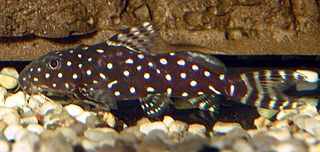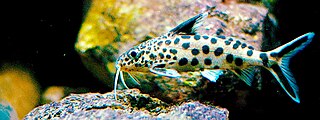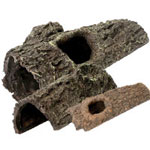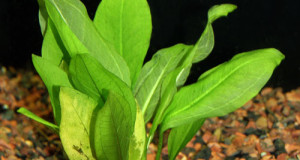Faced with “an embarrassment of riches”, catfish enthusiasts usually find it impossible to single out a favorite species. Those in the genus Synodontis – boldly-marked and fascinating to observe – are a case in point. Each time I’m introduced to a new species, I find some quality that draws me to learn more about it. But if the Angelicus Squeaker, Synodontis angelicus, is not the most sought after of all Synodontis cats, it certainly is in the running. Also known as the Black Clown Catfish, Angelicus Synodontis, Polka-Dot Synodontis and Angel Squeaker, it is both breathtakingly-beautiful and extremely interesting in its habits. And dedicated aquarists have the opportunity to broaden our understanding of the little-studied species, as captive breeding success has remained elusive.
Description
The Angelicus Squeaker’s jet black, dark gray or deep purplish coloration is beautifully offset by numerous yellow or white spots. Some have described it as having the opposite color pattern of another popular relative, the Cuckoo Squeaker, S. multipunctata (please see photo below). Color and spot patterns vary greatly, and individual fishes are capable of radically changing their background colors. Health, stress, age, sex and other factors are likely involved, but much remains to be learned. Fishes involved in aggressive encounters or, perhaps, courtship, sometimes lighten to almost white in color.
The maximum size reported is 9.4 inches, but detailed field surveys have not been carried out, and there are rumors that much larger individuals have been seen. Growth appears to be rather slow, at least by pet catfish standards.
Natural History
This river-dwelling catfish has a large range, but details concerning its exact distribution are sketchy. It is known to occur throughout much of the Congo Basin, and has been reported from Cameroon, the Democratic Republic of the Congo and the Congo Republic.
The Synodontis Aquarium
Angelicus Squeakers remain rather subdued during the day, unless food is detected, but they are very active by night. Although success has been had in smaller accommodations, I believe it best to plan on a 55 gallon aquarium for 1-2 adults.
Angelicus will not thrive if forced to remain in the open. As they can be quite picky when it comes to choosing a hideaway, a variety of caves, hollow logs, driftwood refuges and similar structures should be provided. . This is even more important when 2 or more Angelicus Squeakers are housed together, as battles over favored hiding spots are common. Once a retreat is chosen, your fish will likely remain faithful to it.
Additional security in the form of well-rooted live or artificial plans should also be added. Fishes kept in complex environments will exhibit a greater variety of natural behaviors than those denied access to hiding places…you’ll wind up seeing of your fish, and more of interest!
I like maintaining this and similar Synodontis cats on sand, as they keep very active by rooting about for food. If displaced sand causes problems in your aquarium, they will also do well on smooth gravel.
Temperature and pH
Temperatures of 74-80 F and a pH range of 6.0-8.0 have been used successfully. I have found 78 F and pH 7 to be ideal.
Several friends working in public aquariums and for fish importers have reported seeing what appear to be heater burns on Angelicus Squeakers. I have not seen this in my collection.
Companions
I’ve successfully kept groups of 6-8, but they must be watched carefully, especially at night. Angelicus Squeakers guard their caves, and we know little about male-male rivalry or aggression that may occur when pairs are courting.
They may also be kept with similarly-sized peaceful or moderately aggressive fishes of other species. Active top-feeders will out-compete most catfishes for food, so night-feeding and other accommodations to bottom-feeders will be necessary.
I’ve not tried hosing Angelicus with other catfishes, and, in most situations, would avoid any fish that is dependent upon caves for shelter.
Feeding
Angelicus Squeakers are opportunistic feeders that will readily consume all manner of flake, pelleted and frozen fish foods. Mine especially relished crushed crickets, blackworms and fresh and freeze-dried shrimp.
Plant-based foods are also important. Cucumber, zucchini, spirulina tablets and similar foods should be offered regularly.
Individuals maintained on flakes and pellets alone do not do as well as those provided a diet comprised of live and frozen invertebrates.
Breeding Synodontis Angelicus Catfish
Despite the high demand for these beautiful fishes, captive breeding has not been documented, and little is known of their reproduction in the wild (other than that they are egg-scatterers). Eggs have been produced by Angelicus Squeakers in several private and public collections, but none have hatched. Anecdotal reports hint that hormone-based breeding has been accomplished in Europe, but details are not available.
I’m sure that the key to success lays in a detailed study of their natural habitat…pH, temperature or water level changes may be involved. Where captive spawning has occurred, hatching failures may possibly be linked to nutritional deficiencies. Increased amounts of live and protein-rich foods were offered prior to spawning in some cases. Please let me know your thoughts (or, hopefully, successes!) on this important topic by posting below.
Further Reading
Keeping the Frog Mouth Catfish
Keeping European and Oriental Weatherfish
 That Fish Blog – Aquarium Advice and Information
That Fish Blog – Aquarium Advice and Information






I would like very much to add one of these beautiful catfish to my 90 gallon tank. However, the tank’s other bottom-dwelling occupants include one pleco (approximately 12 inches), and a dozen or so dwarf albino cory cats. I wanted first to make sure that the synodontis catfish would be compatible, especially with the pleco, who has always been peaceful towards all other tank occupants. There are plenty of assorted plants, logs, and other hiding places so that would not be an issue, and the cory cats can be moved to one of my three other aquariums if needed to reduce competition for food at the night feeding.
I would greatly appreciate any advice about the compatibility of these fish. Thank you very much.
Hello Jan,
Thanks for your interest. They usually get along well with plecos, and the corys would not likely present a competition problem, and the set-up sounds ideal. However, individuals differ in their behavior, so it’s advisable to watch the tank, especially at night, for a time. Enjoy and please keep me posted, Frank
Thank you for your response; I’m hoping you can also help me with a problem with one of my plecos. He is about 14 inches long, and has what I assume is a hernia. There is a large protrusion from his vent, which appears to be a tangle of blood vessels. This has been present for a couple of years, but it is steadily growing larger, and is currently about the size of a cherry tomato. Otherwise, he seems be in good health, and his behavior has not changed at all. Do you agree that this is likely to be a hernia, and is there anything that I can do about it? I am also concerned that he may be in pain. As much as I love him, and don’t want to lose him, I would rather euthanize him if he is in severe pain. What do you suggest that I do for him? Thank you for any advice you can give me.
Hi Jan,
It’s generally a prolapse; sometimes resolves on its own but not likely after all this time. Amphibians/reptiles usually expire if untreated, but some fish seem to carry on well. Water quality is important, as bacterial infections can easily take hold, but you likely have that well in hand or would have seen problems by now. be careful not to disturb the fish, or to add others that might harass it etc., as any tear or other injury to the area would be serious. I wouldn’t worry about pain..they operate on a different plane than us re that, and you would have noticed signs of discomfort, lethargy, non-feeding etc. Please keep me posted, best, frank
Thanks! I have been very worried about him, and feel quite relieved now.
My pleasure, Jan. Conditions must be very good in the tank, or he would not be doing so well, congrats on a fine job. Please keep me posted, enjoy, Frank
I love my angelicus.I have had her l8 years now-yep,thats correct,EIGHTEEN years and I think she was about two when I bought her.She’s been a real trouper,as we have moved 4 times with her.She survived a bout of Velvet and is doing great.I sure would like to get another for an empty large tank I have.Wondering how hard they are to get now?Thank you for having this site!
Hello Shary,
Thanks for the kind words. That is a very impressive record, especially considering the moves and disease treatment…congrats!
Availability varies greatly, but they are popular with catfish enthusiasts so hopefully you will find one…I can check shipping options from our store in PA if you wish.
Not sure if you are planning to house them together?…if so, best to isolate the new one until;l you are sure it is healthy. They can be very territorial, especially as regards shelters; animals housed alone may be particularly aggressive…aggression may not occur right away, and at night, so please consider that and let me know if you need more info. When you have a chance, please send along some info as to diet and care…temperature, pH etc….important to record this, since you’ve obviously done very well! Best, Frank
I’ve had an angelicus now for 30 years. He’s been in with many different fish and through many tanks. Now he’s in a 150 gal. He used to come up to the top and I would drop food in his mouth, but he doesn’t do this anymore, I think he is blind now, although I don’t think he could ever see very well. He can be very mean if he wants and he HATES loaches. He has killed many over the years. He doesn’t seem to like any fish that lives on the bottom, but he goes out of his way to attack a loach. He is about 12 inches long and has been a joy to keep, he has quite a personality. I have a pleco in with him and he does chase the pleco but only half heartedly. I’m quite certain he would kill any cory’s if I put them in there. I have some tetra’s and a couple of angle fish and he doesn’t seem interested in them at all. He just wont tolerate any other fish on the bottom. I tried a long time ago to get another sino but he killed it right away. He is very particular.
Hello Tim,
Thanks so much for writing in…very impressive! I find that many people do not realize just how long some fishes, even relatively small species, can be. Great job! I have some loaches and cats in their mid 20’s, but have not heard of any angelicus with a longevity near yours. One species in the genus, larger (I need to check exact species) was recorded at 38 years, but you may have the record for this species. I hope you have him for many years to come – what do catfish need with eyesight anyway! Best regards, frank
Hi Frank,
You were kind enough to answer my question about my pleco’s prolapse sixteen months ago (above). He died last week after the prolapse apparently strangulated.
Now I’m wondering if it I should move my other pleco from his familiar 75 gallon tank to the 90 gallon tank his brother vacated. I’m sure he would enjoy having the added space, but I wonder how stressful such a move would be. He has been in his current aquarium since he was less than a year old, is about 15 years old, and in good health.
Thank so much for your advice.
Hello Frank! I just purchased an Angelicus 3 days ago. I have watched him at night for several days and he has not fed since I purchased him. I have tried night feeding flakes, have tried strategically placing a few Veggie Wafers at the bottom and he just won’t eat. At night when the lights go off he comes out of hiding and just races around the walls of my tank endlessly. He is only about a inch and a half and I’m afraid he might die if he doesn’t eat soon. What can I do to feed this little guy? He’s a gorgeous fish and hard to get here in NJ. Thanks for any suggestions.
Hi Hector, Frank is no longer with our blog but I’d be happy to help you out. Are there any other fish in the tank that may be stressing your Angelicus or getting to the food before it has a chance to feed? You may want to try quarantining it or the other fish until your Angelicus is settled if so. I would also recommend trying some other meatier sinking foods like shrimp pellets or a frozen food like bloodworms or blackworms. Plant matter like your veggie wafers are important as supplements but aren’t a Syno’s primary diet.
Hello Eileen, thanks for the response. Well, I’ve only had him for a few days and No, he pretty much hides throughout the day and then sprints around the walls of the tank all night. He rarely explores the substrate. I have tried Premium Flakes and shrimp pellets as well. I was thinking of separating him into a little nursery cage, but I thought that would stress him more before he actually gets acclimated to his new home. His other tank mates include 10 Glofish, who rarely visit the bottom at all. The only fish that seem curious and snoop in his hiding place are the Neon Tiger Barbs. They don’t chase him around or bother him, but they do snoop around his hiding place till he chases them away. Do u think the nursery idea would be beneficial for him? Many thanks for your advice. Have a goodnight.
Hi Hector, What size is the tank? I’d think that, given that many tankmates, it will likely be less stressful to leave the catfish in the tank rather than try to catch either it or its tankmates out to move into quarantine. You can try adding some extra hiding places if there is enough room in the tank, or leave the lights dimmer for a longer period of time. I would just give it some time to settle in, try some different foods, and make sure it isn’t being tormented by its tankmates. I’m not sure what fish you are referring to as “Neon Tiger Barbs”, but barbs can get pretty nippy, especially if the tank is small.
Hello Eileen. Thanks again for the suggestions. The tank is a 40Gal Tall Bowfront, and all his tank mates are babies, smaller than him actually and they don’t bother him at all. The only worry I have is that he NEVER explores the substrate where all the food is. All he does is laps around the tank walls all night. It’s funny to watch actually, but I have NEVER witnessed him feed. I just lost a pleco this way and I’m worried he’s next if he doesn’t feed. I’ll wait a couple of more days. He’s a little more active during the day now that I leave the light off, but still no bottom feeding. I tried Blood Worms last night and I eventually fell asleep watching him and he did not go after the live blood worms at all. Well, at least while I was awake watching him. He’s really stressing me out this little guy. Thanks for your help, and if you have any other suggestions please shoot them my way. Thanks!!
I thought I’d tell you a story. I have a 280l tank and about 8yrs ago I went to the local pets at home to see if there were any pleccys for rehousing as my tank warranted a big one:).. anyway they (unusually) didn’t have one but they asked if I would adopt a strange fish. An 80yr old lady had passed away and she had owned a fish for 20yrs plus but it was scared as it lived in its little plastic tunnel and didn’t come out and it looked a bit odd. So I had a look at this poor thing and most of its Tain was missing except a long bit at the top, no dorsal fin except for an appendage, one cloudy eye and no side fins. He was a pale tan colour and dusky. So being a softy and liking the idea of having an equality and diversity compliment tank ;). I took him home. He still live we me in my tank, having survived 2 moves. And I’m pleased to say he has grown by an inch to around 6 inches, is a lovely dark brown with yellow spots and his side fins have grown a bit. I love his nature. He loves his plastic helicopter ship wreck. Love him :). Didn’t know what species he was or where from and today came across this thread :). Glad I did.
Hope you enjoyed that story 🙂 shame I don’t know how to post a picture of him. We reckon he could be in the region of 20 and a lot years old. Bless x
Thanks for sharing, Julie!
Are these fish compatible to live with female bettas as i was thinking of getting one?
Hi Nathan, It would depend on the size of the tank, but I wouldn’t recommend this Synodontis with a female Betta. If the tank was large enough – at least 20 gallons I’d say – you could go with one of the smaller Synodontis species like the Pygmy Synodontis or Upside-down Catfish. I wouldn’t attempt any species that grows to over about 4-5 inches in length.
Hello there I have a synodontis in 35 gallon will upgrade when he gets bigger I’ve named him Ceaser. He is currently around 6-7cm, but I have a fine black gravel but I have read thay they are diggers I see him dig sometimes to hide especially when I first got him around 2 weeks ago. I’m just wondering if I should change my substrate to a finer sand. And how to do so without killing my synodontis. Also he has claimed the centre peice of the tank. They’re are many other hiding places would it be suitable to put my red tail in there around an inch.
Hi Lucas, Fine gravel should be fine. If you would like to switch to a sand, I would do that when you upgrade. If the Synodontis has set up its territory, adding another bottom-dweller with be tricky. You can try totally rearranging the tank when you add a new fish to break up the existing landscape and “reset” the territory but it can be difficult to get a territorial fish to relinquish its claim, especially in something that small. Also, what do you mean b “Red tail”? Catfish or loach or some other type of fish? be sure that whatever you are adding is also suitable for the tank and tankmates. If it is a fish like a South American Redtail Catfish, keep in mind that they get VERY VERY large and will eat anything that fits into their (rather large) mouth.